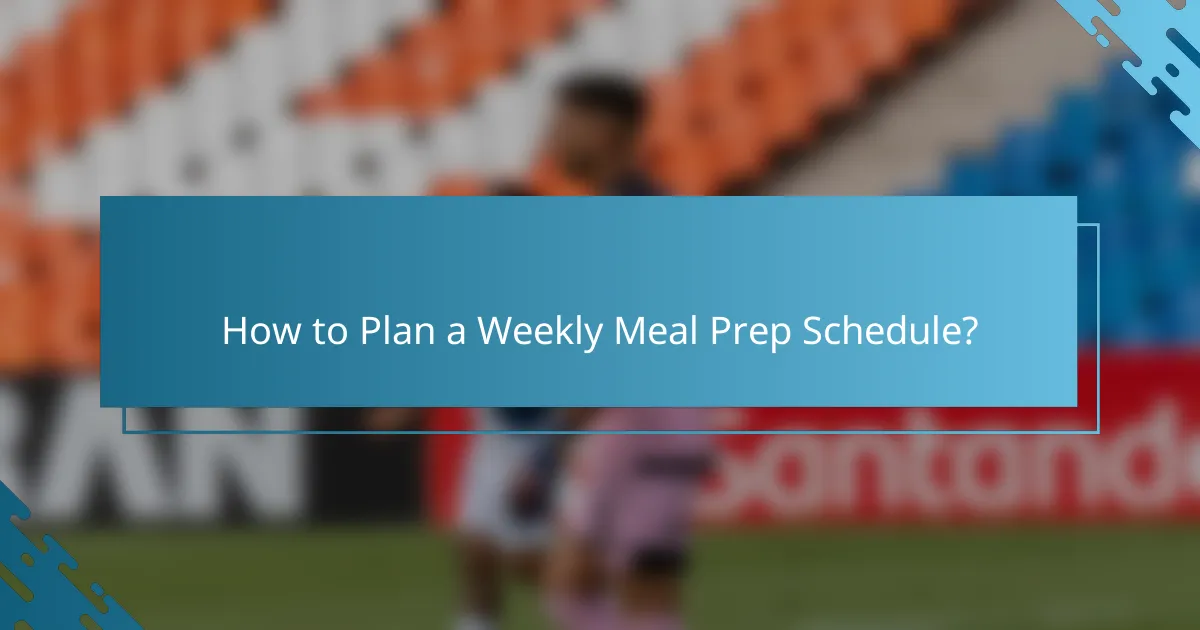For competitive athletes, budget-friendly meal prep is essential in maintaining peak performance while managing costs. By carefully selecting nutritious ingredients and planning meals in advance, athletes can optimize their dietary intake to support training and recovery. This approach not only enhances energy levels but also ensures that nutritional needs are met without breaking the bank.

What Are Budget-Friendly Meal Prep Ideas for Athletes?
Budget-friendly meal prep ideas for athletes focus on nutritious, cost-effective ingredients that support performance and recovery. By planning meals in advance, athletes can save money while ensuring they meet their dietary needs.
Rice and Bean Bowls
Rice and bean bowls are a staple for athletes looking for a balanced meal that is both affordable and filling. Combining brown rice with black or pinto beans provides a complete protein source, essential for muscle repair.
To prepare, cook a large batch of rice and beans, then add vegetables like bell peppers and corn for added nutrients. Season with spices such as cumin or chili powder for flavor. These bowls can be stored in the fridge for several days, making them a convenient option.
Overnight Oats
Overnight oats are an excellent breakfast choice for athletes, offering a quick and nutritious start to the day. By soaking oats in milk or yogurt overnight, they become soft and ready to eat in the morning.
Mix oats with ingredients like chia seeds, fruits, and nuts for added fiber and healthy fats. This meal is not only budget-friendly but can also be customized to suit different tastes and dietary needs.
Vegetable Stir-Fry
A vegetable stir-fry is a versatile and economical meal prep option that allows athletes to use seasonal vegetables. Stir-frying helps retain nutrients while providing a quick cooking method.
Choose a mix of colorful vegetables such as broccoli, carrots, and bell peppers, and pair them with a protein source like tofu or chicken. Serve over brown rice or whole grain noodles for a complete meal that can be easily reheated.
Chicken and Quinoa Salad
Chicken and quinoa salad is a nutritious meal that combines lean protein with whole grains. Quinoa is a complete protein, making it an excellent choice for athletes looking to build muscle.
Cook quinoa and mix it with grilled chicken, fresh vegetables, and a light dressing. This salad can be prepared in bulk and stored for several days, providing a convenient option for lunch or dinner.
Egg Muffins
Egg muffins are a simple, protein-packed snack or breakfast that can be made in advance. By whisking eggs with vegetables and cheese, you can create a nutritious bite-sized meal.
Pour the mixture into a muffin tin and bake until set. These muffins can be frozen and reheated, making them a practical choice for busy athletes looking to maintain their nutrition on a budget.

How Can Meal Prep Enhance Athletic Performance?
Meal prep can significantly enhance athletic performance by ensuring that athletes have access to nutritious meals tailored to their training needs. By planning and preparing meals in advance, athletes can optimize their nutrient intake, manage their energy levels, and support recovery processes effectively.
Improved Nutrient Timing
Meal prep allows athletes to time their nutrient intake strategically around their training sessions. Consuming the right balance of carbohydrates, proteins, and fats before and after workouts can maximize performance and recovery. For instance, a meal rich in carbohydrates and protein consumed within 30 minutes post-exercise can help replenish glycogen stores and repair muscle tissue.
To optimize nutrient timing, consider preparing meals that include a mix of complex carbohydrates and lean proteins. Examples include quinoa with grilled chicken or sweet potatoes with black beans. Having these meals ready to go can make it easier to stick to a consistent eating schedule.
Consistent Energy Levels
Consistent energy levels are crucial for athletes to maintain peak performance throughout their training and competitions. Meal prep helps by providing balanced meals that prevent energy crashes often caused by poor food choices or skipped meals. Regularly scheduled meals can help stabilize blood sugar levels, allowing for sustained energy.
To maintain energy, aim for meals that include a source of protein, healthy fats, and fiber. For example, a meal of brown rice, salmon, and steamed broccoli can provide lasting energy. Preparing these meals in advance ensures that athletes have nutritious options readily available, reducing the temptation to opt for unhealthy snacks.
Better Recovery
Effective recovery is essential for athletes to perform at their best. Meal prep can enhance recovery by ensuring that athletes consume the necessary nutrients to repair muscles and reduce inflammation after intense workouts. Foods rich in antioxidants, omega-3 fatty acids, and vitamins can support this process.
Incorporate foods like berries, leafy greens, and fatty fish into your meal prep to promote recovery. Preparing recovery smoothies with spinach, banana, and protein powder can also be a convenient option. Having these meals ready can help athletes avoid the pitfalls of post-workout hunger and make healthier choices that support their recovery goals.

What Are Key Nutritional Considerations for Competitive Athletes?
Competitive athletes must focus on a balanced diet that supports their training and performance goals. Key nutritional considerations include macronutrient ratios, hydration strategies, and micronutrient needs, all of which play a crucial role in optimizing energy levels and recovery.
Macronutrient Ratios
Macronutrient ratios are essential for fueling athletic performance. A common guideline suggests that athletes consume approximately 50-60% of their total daily calories from carbohydrates, 20-30% from fats, and 15-25% from proteins. This balance helps maintain energy levels during intense training and supports muscle repair.
For example, a 2,500-calorie diet might include 300-375 grams of carbohydrates, 55-85 grams of fat, and 90-150 grams of protein. Adjusting these ratios based on training intensity and duration can enhance performance and recovery.
Hydration Strategies
Hydration is critical for maintaining performance and preventing fatigue. Athletes should aim to drink water consistently throughout the day, with specific focus on pre-, during, and post-exercise hydration. A general recommendation is to consume about 500-700 mL of water 2-3 hours before exercise and 200-300 mL every 10-20 minutes during activity.
In addition to water, electrolyte-rich drinks can be beneficial during prolonged exercise or in hot conditions. Monitoring urine color can help athletes gauge hydration status; pale yellow indicates adequate hydration, while darker shades suggest a need for more fluids.
Micronutrient Needs
Micronutrients, including vitamins and minerals, are vital for energy production and overall health. Athletes should ensure they meet their daily requirements for key nutrients such as calcium, iron, and vitamin D, which support bone health and muscle function. A varied diet rich in fruits, vegetables, whole grains, and lean proteins typically provides these essential micronutrients.
For instance, athletes may need to pay special attention to iron intake, particularly female athletes, who are at higher risk of deficiency. Incorporating sources like red meat, beans, and fortified cereals can help meet these needs effectively.

How to Choose the Right Meal Prep Containers?
Choosing the right meal prep containers is essential for maintaining food quality, portion control, and convenience. Consider factors like material, size, and safety features to ensure your containers meet your meal prep needs effectively.
Material Types
Meal prep containers come in various materials, including plastic, glass, and stainless steel. Plastic containers are lightweight and often more affordable, but they may not be as durable or safe for high temperatures. Glass containers are heavier but offer better heat resistance and are generally microwave and dishwasher safe.
Stainless steel containers are durable and eco-friendly but can be more expensive. When selecting materials, look for BPA-free plastics and glass that can withstand temperature changes without breaking.
Size and Portion Control
Choosing the right size for your meal prep containers is crucial for portion control and minimizing food waste. Containers typically range from 250 ml to 1 liter or more, allowing you to select sizes that fit your meal plans. Consider using smaller containers for snacks and larger ones for main meals.
To maintain balanced nutrition, aim for containers that allow you to separate different food groups. This can help you manage portions effectively and ensure you’re getting a variety of nutrients in your diet.
Microwave and Dishwasher Safety
Microwave and dishwasher safety is a key consideration when selecting meal prep containers. Look for containers labeled as microwave-safe to avoid harmful chemicals leaching into your food. Most glass and high-quality plastic containers are designed for microwave use, but always check the manufacturer’s guidelines.
For dishwasher safety, ensure the containers are marked as dishwasher-safe. This feature simplifies cleaning and helps maintain the longevity of your containers. Avoid placing containers with metal components in the microwave or dishwasher to prevent damage.

What Are Common Mistakes in Meal Prep for Athletes?
Common mistakes in meal prep for athletes include misjudging portion sizes, lacking variety in meals, and not including adequate protein sources. These errors can hinder performance and recovery, making it essential to address them for optimal nutrition.
Ignoring Portion Sizes
Ignoring portion sizes can lead to either overeating or under-eating, both of which can negatively impact athletic performance. Athletes should aim for balanced meals that meet their energy needs, which can vary based on training intensity and duration.
A practical approach is to use measuring cups or a food scale to determine appropriate serving sizes. For example, a typical meal might consist of a palm-sized portion of protein, a fist-sized portion of carbohydrates, and a handful of vegetables.
Neglecting Variety
Neglecting variety in meal prep can result in nutrient deficiencies and decreased motivation to stick to a meal plan. Consuming a wide range of foods ensures athletes receive essential vitamins and minerals necessary for optimal performance and recovery.
To incorporate variety, athletes can rotate different protein sources, such as chicken, fish, and legumes, and include various fruits and vegetables. Planning meals around seasonal produce can also enhance diversity while keeping costs down.
Inadequate Protein Sources
Inadequate protein sources can impair muscle repair and growth, essential for competitive athletes. It is crucial to include sufficient protein in each meal to support recovery and overall performance.
Aim for a protein intake of around 1.2 to 2.0 grams per kilogram of body weight, depending on training intensity. Good sources include lean meats, dairy, eggs, and plant-based options like tofu and beans. Incorporating protein-rich snacks, such as Greek yogurt or protein shakes, can also help meet daily requirements.

How to Plan a Weekly Meal Prep Schedule?
To effectively plan a weekly meal prep schedule, start by outlining your meals for the week, focusing on balanced nutrition and budget considerations. This approach helps streamline grocery shopping, cooking, and ensures you have nutritious meals ready for your training needs.
Identify Your Nutritional Needs
Understanding your nutritional needs is crucial for competitive athletes. Focus on macronutrients: carbohydrates for energy, proteins for muscle repair, and healthy fats for overall health. Tailor your intake based on your training intensity and goals, ensuring you meet daily requirements.
Create a Meal Plan Template
Design a meal plan template that includes breakfast, lunch, dinner, and snacks for each day. Consider using a simple table format to organize meals by day and type. This structure helps visualize your week and ensures you include a variety of foods to meet your nutritional needs.
Grocery Shopping and Budgeting
When grocery shopping, create a list based on your meal plan to avoid impulse buys and stick to your budget. Look for sales, buy in bulk, and choose seasonal produce to save money. Aim to allocate a specific budget, such as $50-$100 per week, depending on your dietary preferences and local prices.
Meal Preparation Techniques
Efficient meal preparation techniques can save time and enhance your meal prep experience. Batch cooking, where you prepare large quantities of food at once, is effective. Use containers to portion meals for the week, ensuring they are easy to grab and go. Consider cooking staples like grains and proteins in bulk to mix and match throughout the week.
Storage and Reheating Tips
Proper storage is essential for maintaining food quality and safety. Use airtight containers to store meals in the refrigerator or freezer, labeling them with dates. When reheating, ensure food reaches a safe temperature, typically around 75°C (165°F), to avoid foodborne illnesses. Avoid reheating multiple times to preserve taste and texture.
